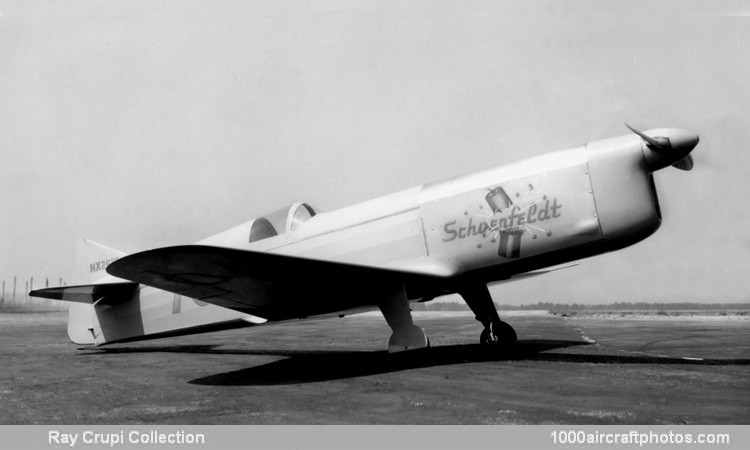10/31/2010. Remarks by Johan Visschedijk: "For the 1936 National Air Races Keith Rider designed and built the R-4. Powered by a 200 hp Menasco B6S Buccaneer inverted six-cylinder air-cooled engine with a displacement of 489 cu.in (8.01 l), the aircraft had a steel tube structure and was covered with plywood and fabric. The hand-cranked wide tracked landing gear folded inward into the wings and fuselage.
Registered NR261Y and listed as Racer number "70", the yellow painted aircraft was flown at the 1936 Nationals, held at Los Angeles Mines Field, California, September 4 to 7, 1936. Pilot was Roger Don Rae, who won Shell Speed Dashes with a speed of 225.544 mph (362.978 kmh), finishedthird in the Thompson Trophy Race with a speed of 236.559 mph (380.705 kmh).
Subsequently the aircraft was sold to Bill Schoenfeldt who replace the B6S Buccaneer by a similar 260 hp C6S-4 Super Buccaneer with a displacement of 544 cu.in (8.91 l), as the new engine was longer it shifted the center of gravity, which needed counter-balancing. Named "Schoenfeldt Firecracker" the re-engined R-4 first raced in the 1937 International Air Races in St. Louis, Missouri, May 29 to 31.
Flown by Gus Gotch it placed second (239.9 mph, 386.1 kmh), upon landing the aircraft nosed over, damaging its propeller and engine cowl. A new propeller was flown in from Los Angeles, and the aircraft entered the Missouri Brewer's Association Trophy Race on the last day. Again with Gus Gotch at the controls the aircraft won the race (251.6 mph, 404.9 kmh). Later that year Gotch flew it at the Nationals at Cleveland, Ohio, September 3 to 6, 1937, it placed third in the Greve Trophy Race (231.59 mph, 372.71 kmh), and seventh in the Thompson Trophy Race (217.81 mph, 350.53 kmh).
At the International Air Races in Oakland, California, May 28 to 30, 1938, the R-4 was flown by Tony LeVier, and the combination won the Free-For-All Races of 75 mls (121 km) at 249.351 mph (401.292 kmh) and 100 mls (161 km) at 251.010 mph (403.961 kmh), and placed third in the Golden Gate International Exposition Trophy Race at 260.762 mph (419.656).
At the 1938 Nationals at Cleveland, September 3 to 5, the R-4 was flown again by Tony LeVier winning the Greve Trophy Race at 250.886 (403.762). Landing downwind LeVier overshot the runway and the R-4 hit a cross runway. The impact broke both wing spars and cracked the plywood covering from tip to tip, and the 1938 racing season was over for the "Firecracker".
Rebuilt for the 1939 Nationals at Cleveland, September 2 to 4, the R-4 still wore its original yellow paint scheme and the Racing number "70". LeVier entered the aircraft in the Greve Trophy Race, but in the eleventh of the twenty laps, the engine began to misfire and LeVier aborted the race. Later the combination participated in the Thompson Trophy Race, ending second at 272.538 mph (438.607 kmh).
As air races were suspended due to the outbreak of WW II, the R-4 was stored and reportedly since was cannibalized and eventually disposed of. However the "Schoenfeldt Firecracker" name lives on in a replica that is presently on display at the Planes of Fame Air Museum at Chino, California. Construction was started by Stan Rackleff of Flabob, California, sometime in the 1980s, taken over by Tom Wathen in the 1990s and was completed in 2005. It has been flown on a number of occasions by Major General Patrick Halloran."
